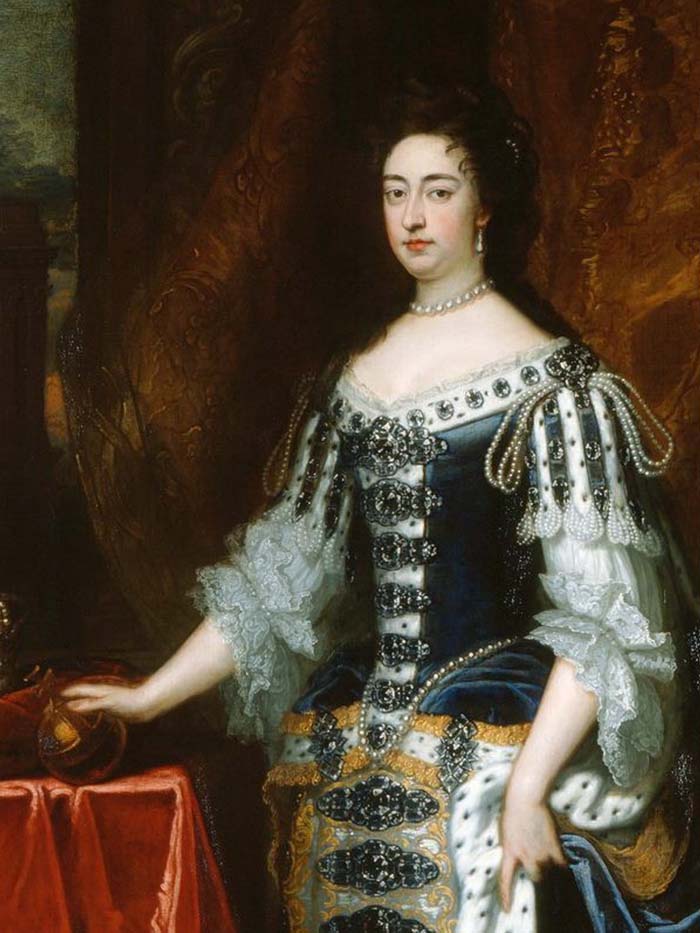
“Thou shalt not steal.” —Exodus 20:15
Captain Kidd Executed for Piracy, May 23, 1701

Captain William Kidd (1655-1701)
|
 n the golden age of piracy, no pirate left a bolder trail, more details of his career, or more loot unaccounted for after his capture, than William Kidd. His case involved or implicated Lords of the highest rank in England, including the King himself, as initial investors in his enterprise. It began with letters of marque for privateering against the French, which quickly spun out of control to include the taking of prizes outside the law, mutinies, seizing English ships, hidden treasure and finally, arrest, incarceration, a sensational trial, and execution. And it was all recorded in detail, unlike most piratical activities of the 17th and 18th Centuries; some historians believe Captain Kidd a victim of politics and misunderstanding. n the golden age of piracy, no pirate left a bolder trail, more details of his career, or more loot unaccounted for after his capture, than William Kidd. His case involved or implicated Lords of the highest rank in England, including the King himself, as initial investors in his enterprise. It began with letters of marque for privateering against the French, which quickly spun out of control to include the taking of prizes outside the law, mutinies, seizing English ships, hidden treasure and finally, arrest, incarceration, a sensational trial, and execution. And it was all recorded in detail, unlike most piratical activities of the 17th and 18th Centuries; some historians believe Captain Kidd a victim of politics and misunderstanding.

Greenock, Scotland, and across the Firth of Clyde towards Kilcreggan
William Kidd was born to a Presbyterian minister in Greenock, Scotland, at the height of the Second Scottish Reformation. Kidd went to sea at an early age, and by 1689 commanded a privateering ship, The Blessed William. He fought the French in the Caribbean on behalf of the co-monarchs William and Mary, though his crew hijacked the ship, leaving him stranded on the Island of Nevis. Within two years, Kidd landed in New York with a new ship and crew. He soon married a local heiress and established himself in several local business ventures. In 1695 William Kidd returned to London to raise money for another privateering venture, hoping to open an entirely new enterprise supported by men of wealth and influence.

William III of England (1650-1702)
|
|

Mary II of England (1662-1694)
|
Several Whig peers—and even the King—invested in Kidd’s scheme, forming a syndicate to enable him to purchase a large fighting ship, hire another tough buccaneering crew, and sail to the Indian Ocean to take both pirate ships and French merchantmen. The usual financial arrangements for paying the crew and the investors hinged on selling captured ships and contents in prize courts. Letters of marque were obtained to hunt down “Pirates, Freebooters, and Sea Rovers,” especially Captains “Thomas Tew, John Ireland, Thomas Wake and William Mace.” The King (William III), allowed for Kidd to skip the Admiralty Courts so he could receive direct payments himself!

An artist’s rendition of a scene aboard Captain Kidd’s ship while anchored in New York Harbor
The 34-gun Adventure Galley set sail in April 1696 for New York to recruit the 152-man crew described by the Governor of New York as “men of desperate fortunes, and necessitous of getting vast treasure.” Serving under Captain Kidd was no picnic, for he was “a very lusty man, fighting with his men on any occasion, often calling for his pistols and threatening any one that durst speak anything contrary to his mind to knock out their brains, causing them to dread him.”

The Charles Galley, a ship of similar build and contemporary of Adventure Galley
After months of no action, the crew became mutinous, and Kidd decided to attack the “pilgrim fleet” moving toward the Red Sea. The Adventure Galley then seized a merchant ship flying the English flag, the turning point in Kidd’s career. The Portuguese sent two warships to track down Kidd’s ship, now considered a pirate. He defeated them and sailed to a small group of islands nearby, where his crew committed various atrocities on the inhabitants. Captain Kidd struck down a recalcitrant crew member, who died the next day, Kidd saying he would be exonerated by friends in England. They next took the Quedah Merchant, flying the French flag, but with an English captain. That cargo was quickly sold so the crew could receive long deferred pay. He took over the captured ship and with a crew of just twenty men, sailed to the Caribbean.

The French pass Kidd acquired from the Quedagh Merchant
England declared Captain Kidd a pirate, alerting all the colonial governors to apprehend him and the crew if opportunity afforded. Unfortunately, Kidd got blamed for a number of depredations by other pirates, enhancing his reputation in a way guaranteed to be detrimental to his future. He returned to New York, hoping to negotiate a pardon from Governor Lord Bellomont, his business partner and financier of his voyages. After an absence of three years, Captain Kidd was reunited with his wife and daughters, and spent time on Gardiner’s Island off Long Island. Upon a visit to the governor, Kidd was arrested.

Richard Coote, 1st Earl of Bellomont and 12th Governor of New York (1636-1701)

The notorious Newgate Prison, London
|
The political interest in Kidd ran high in England also, for reputations were on the line and political scandals the finest grist for the news media of the day. The East India Company sought compensation and everyone wondered what happened to the treasure that Kidd allegedly accumulated but failed to cash in: jewels, gold bars, and silver. A warship carried Captain Kidd to England, where he spent time in three different prisons including the worst, Newgate. Kidd argued in court and to the Admiralty that he only took French ships and that his patrons would vouch for his honesty. As it turned out, they did not. Captain Kidd, pirate, was hanged May 23, 1701, age about 56.

The body of Captain William Kidd, gibbeted after execution as a warning to other would-be pirates, as was commonly done at the time
His Bible and several other artifacts from his life are on display at the Pirate Museum in St. Augustine, Florida, and his lost treasure—if there was such—remains undiscovered. He should have paid more attention to his Bible, and less to his lust for preferment, wealth, and fame.


Under the Black Flag: The Romance and the Reality of Life Among the Pirates, by David Cordingly (1995)

Image Credits:
1 William Kidd (Wikipedia.org)
2 Greenock, Scotland (Wikipedia.org)
3 King William III (Wikipedia.org)
4 Queen Mary II (Wikipedia.org)
5 Kidd in New York (Wikipedia.org)
6 Charles Galley (Wikipedia.org)
7 French pass (Wikipedia.org)
8 Governor Bellomont (Wikipedia.org)
9 Newgate Prison (Wikipedia.org)
10 Hanging (Wikipedia.org)
|







